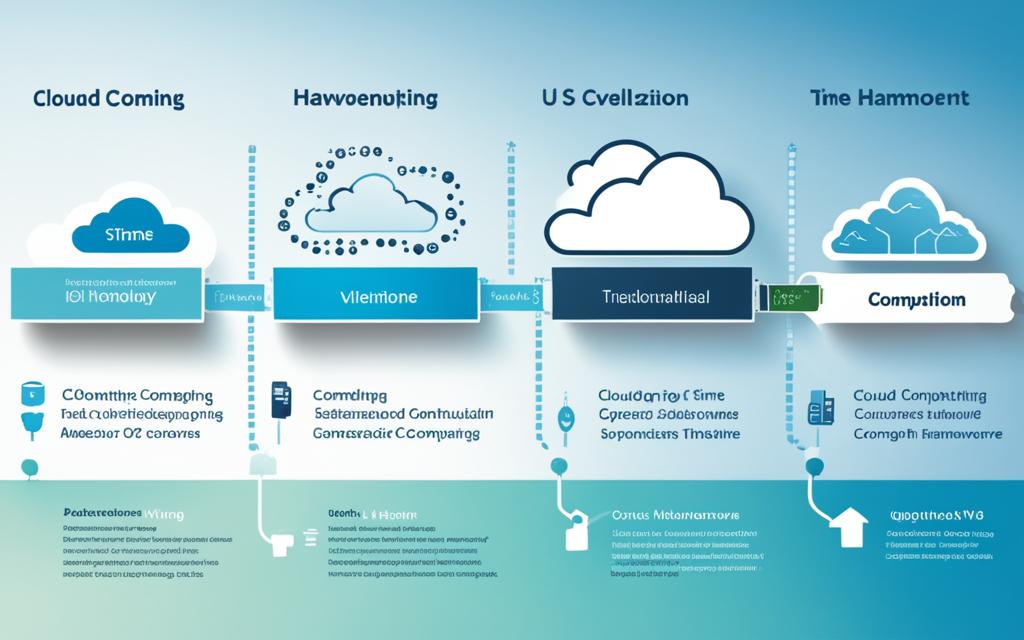Table of Contents
Cloud computing has changed the tech world a lot. It started with basic ideas and became key in today’s IT setup. The name “cloud computing” got popular in the 2000s but began in the 1950s with time-sharing systems. The path of cloud computing is full of key moments.
One major event was the start of Amazon Web Services (AWS) in 2006. This opened doors to services like Software as a Service (SaaS) and Infrastructure as a Service (IaaS). These changes have made cloud computing vital for businesses everywhere123.
Key Takeaways
- The rise of cloud computing began with early innovations in computing technology.
- Amazon Web Services (AWS) launched in 2006, marking a significant milestone in cloud services.
- Cloud computing offers various service models, including SaaS and IaaS.
- Cloud services spending is projected to reach nearly $600 billion by 2023.
- Virtualisation technology has played a crucial role in enabling cloud computing.
- Understanding the history of cloud computing helps in appreciating its current applications.
Introduction to Cloud Computing
Cloud computing is changing how we get computing services. It lets us use the internet to access resources, making things more efficient. What does cloud computing mean? It’s basically a flexible system. It allows businesses to grow without spending a lot on their own infrastructure.
The advantages of using cloud computing are huge. It sparks digital change in many areas. With things like storage and software online, everyday tasks get easier. Companies like Salesforce.com have changed the game by putting business apps on the internet4.Learn more about the various parts of cloud computing.
The history of cloud computing is also full of big moments. The 1990s started it all, setting the stage for what we see now. The launch of Amazon Web Services (AWS) and new technologies were major steps forward5. As firms keep picking cloud solutions, we can expect even more growth and new ideas ahead.
Early Developments in Computing Technology
The journey of computing technology is filled with milestones that shaped today’s digital world. From the 1960s, innovations led to more efficient and accessible systems. These key moments are vital to understanding how technology evolved to what surrounds us today.
Time-Sharing Systems of the 1960s
In the 1960s, a big change occurred with time-sharing systems. This meant many people could use one mainframe computer together. It made using shared computing resources much better. IBM and DEC were crucial in making this possible, pushing technology forward in that era. John McCarthy’s work on time-sharing opened the door for what we now know as cloud computing6.
The Birth of the Internet in the 1980s
The 1980s brought the internet, changing technology forever. It made exchanging data globally possible, letting us access computing resources from anywhere. TCP/IP protocols laid the groundwork, making the internet’s vast effects possible. This set the stage for cloud computing platforms that are essential today7.
| Year | Notable Events |
|---|---|
| 1960s | Introduction of time-sharing systems by IBM and DEC. |
| 1980s | The birth of the internet and establishment of TCP/IP protocols. |
| 1997 | The word ‘cloud’ was first mentioned by Ramesh Chellappa. |
| 2002 | Amazon established Amazon Web Services as a subsidiary. |
Major Innovations Leading to Cloud Services
Since 1989, the invention of the World Wide Web by Tim Berners-Lee has drastically changed our world. It made sharing information and resources between people and businesses much easier. This was a big step towards the birth of cloud computing. Now, we can access services online easily, thanks to the impact of the web. This progress laid the groundwork for cloud services that are now key to many industries.
The Invention of the World Wide Web
The World Wide Web started a revolution in how we access online services. It made things simpler for businesses, encouraging them to offer services online. This big leap made the web central to cloud technology’s growth. Cloud technologies span across Infrastructure as a Service (IaaS), Platform as a Service (PaaS), and Software as a Service (SaaS). It’s important to understand how the web has shaped cloud computing’s path.
Virtualisation Technology and Its Impact
In the late 1990s, huge steps were made with virtualisation technology, like with the creation of VMware Workstation. Virtualisation lets many virtual machines run on one single physical server. This means resources are used better, costs go down, and cloud services can scale up easily. These benefits are crucial to cloud infrastructure and have changed how we manage and consume resources. Cloud services use this technology to be more reliable and perform better, helping businesses make the most of their IT setups.
Cloud computing is always changing, and the combination of virtualisation and web technologies is leading to new innovations. These two parts working together are key to modern applications. They show how we’re always adapting in a world that’s connected online. For more on this topic, you can find a detailed history of cloud computing here. It covers the important steps from the beginning to now in the digital world.
| Year | Innovation | Impact |
|---|---|---|
| 1989 | Invention of the World Wide Web | Revolutionised information sharing and online services |
| 1990s | Advent of Virtualisation | Enabled efficient resource use and scalability in cloud services |
| 2000s | Popularisation of Cloud Services | Facilitated widespread adoption of cloud computing solutions |
Key Milestones in the 2000s
The early 2000s changed cloud computing forever. The AWS launch in 2006 was a major turning point, making Amazon Web Services a key player. This event was a big deal because AWS showed off its Elastic Compute Cloud (EC2) service. EC2 let people run their applications on a system that could grow or shrink without being limited by physical servers. This was a big step forward for the IaaS development model.
Launch of Amazon Web Services (2006)
The story of Amazon Web Services is quite interesting, starting in 2002 with its public cloud launch. But it was in 2006, with EC2’s arrival, that really shook things up9. AWS made it possible to have computing power on tap, inspiring others to create their own cloud services to compete.
Emergence of SaaS and IaaS
In the mid-2000s, not just AWS, but also SaaS and IaaS models began to take off. Salesforce led the way in emergence of SaaS, helping businesses handle applications better while also cutting down on IT costs. This shift changed how we think about tech infrastructure, leading to better performance and more flexible operations. Big names like Microsoft and Google also joined the cloud race, showing how popular and successful these cloud service models were becoming10.
The move towards cloud computing also put a spotlight on user convenience. It allowed organisations to use resources over the internet with a subscription. This setup not only provided storage solutions but also made it easier for teams to work together on developing and deploying projects. It confirmed the importance of cloud strategies in the evolution of tech.
| Year | Milestone/Event | Impact |
|---|---|---|
| 2002 | Amazon Web Services launches public cloud | Introduced cloud computing to the mainstream market. |
| 2006 | AWS launches Elastic Compute Cloud (EC2) | Transformational impact on IaaS and cloud scalability. |
| 2009 | Microsoft Azure enters cloud market | Increased competition in cloud services. |
| 2005-2011 | First generation of cloud services evolves | Introduction of database services and private clouds. |
History of Cloud Computing Timeline
The cloud computing timeline shows an exciting evolution. It highlights key moments from the early ideas of the 1960s to today’s advanced services. Initially, it was all about sharing time and remote job entry which laid the foundation11. Major milestones include Amazon Web Services starting in 2002. It changed the game and earned $7.88 billion by 2015, becoming a leading provider12. In 2010, the launch of Microsoft Azure marked speedy progress in cloud technology11.
Significant Events from the Early Days to 2010
Important innovations like Google Docs began in 2006. Then, in 2008, NASA created the first open-source software for clouds11. By 2010, cloud computing had grown from a new idea into a booming industry. This period showed a shift towards public and hybrid clouds, cutting IT costs and boosting efficiency13.
Evolution of Cloud Technologies Post-2010
After 2010, cloud computing saw significant growth. New advancements like AWS Outposts in 2019 came along, and cloud use soared during the 2020 pandemic13. By 2024, spending on cloud services is expected to reach more than $429 billion. This forecast indicates cloud computing will continue to play a key role in business12. Google and Microsoft have been expanding their cloud solutions. This increased competition has led to better services, stronger security, and more flexibility for users11.
FAQ
What is cloud computing?
Cloud computing is when you get computing services like storage and software over the internet. It lets users access what they need remotely, without having their own big computer infrastructure.
How has cloud computing evolved over time?
Cloud computing started with time-sharing in the 1960s. It grew with Amazon Web Services in 2006. Now, it includes hybrid clouds and big tech developments.
What are the main service models in cloud computing?
Cloud computing has three main models. Software as a Service (SaaS), Infrastructure as a Service (IaaS), and Platform as a Service (PaaS). They offer varying levels of control and management.
Why is cloud computing important for businesses?
Cloud computing lets businesses scale easily and save costs. It means they can focus on their main work, while someone else manages the tech and apps.
What role did the internet play in the rise of cloud computing?
The internet was key to cloud computing because it connected the world. It made it easy to access computing services and helped grow new services and apps.
Who invented the World Wide Web, and how is it connected to cloud computing?
Tim Berners-Lee invented the World Wide Web in 1989. It changed how we share information. This helped create cloud computing and services that use the internet.
What is the future outlook for cloud computing?
Cloud computing is expected to grow, with spending set to hit 9 billion by 2024. This points to more innovation, competition, and cloud tech in businesses.
Source Links
- https://www.verdict.co.uk/analyst-comment/cloud-computing-timeline/ – Cloud Computing: Timeline
- https://www.techtarget.com/whatis/feature/The-history-of-cloud-computing-explained – The history of cloud computing explained
- https://www.cloudzero.com/blog/history-of-the-cloud/ – The Simple Guide To The History Of The Cloud
- https://timelines.issarice.com/wiki/Timeline_of_cloud_computing – Timeline of cloud computing – Timelines
- https://www.geeksforgeeks.org/history-of-cloud-computing/ – History of Cloud Computing – GeeksforGeeks
- https://atos.net/en/blog/decoding-the-cloud-computing-timeline – Decoding the Cloud Computing timeline
- https://en.wikipedia.org/wiki/History_of_cloud_computing – History of cloud computing
- https://hivenet.com/post/cloud-computing-history – A clear timeline of cloud computing history
- https://testbook.com/history-of/cloud-computing – History of Cloud Computing: Check Brief History, Timeline Here!
- https://www.bcs.org/articles-opinion-and-research/history-of-the-cloud/ – No title found
- https://en.wikipedia.org/wiki/Cloud_computing – Cloud computing
- https://community.ibm.com/community/user/cloud/discussion/history-of-cloud-computing – History of Cloud Computing. | IBM TechXchange Cloud User Group
- https://www.educba.com/history-of-cloud-computing/ – History of Cloud Computing | Brief Overview of Cloud Computing









